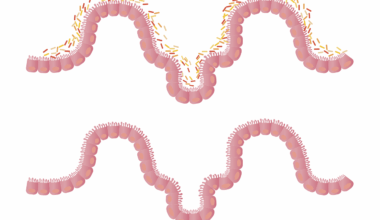Periodization Strategies for Anaerobic Training in Football
Football athletes are required to possess high anaerobic fitness to perform optimally during matches. This performance can be significantly influenced by effective training protocols aimed at enhancing their anaerobic power and capacity. Periodization, the systematic planning of athletic training, allows for structured approaches to optimize training loads and recovery phases. In football, anaerobic conditioning focuses on developing short bursts of power, crucial for sprints and tackles. The training regimen should include exercises like high-intensity interval training (HIIT) to increase the anaerobic threshold. It’s essential to incorporate various modalities, including sprinting, plyometrics, and strength training, to ensure a well-rounded conditioning program. Coaches should monitor progress meticulously to adjust training loads based on player fatigue and performance data. By balancing intensity and volume, players can maximize their anaerobic adaptations while minimizing the risk of injury due to overtraining. Additionally, integrating sport-specific drills can enhance transferability, ensuring athletes are prepared for match scenarios. Ultimately, football fitness professionals must tailor periodization strategies to meet individual athlete needs, fostering optimal performance throughout the competitive season.
A vital element in anaerobic conditioning is the implementation of recovery protocols, which serve to enhance adaptive responses to training. Athletes often overlook recovery, but it plays a significant role in overall performance. To optimize recovery, incorporating active recovery sessions within the training program is beneficial. This can include light jogging, cycling, or swimming, allowing the body to clear lactic acid accumulated during intense training. Furthermore, the inclusion of nutritional strategies cannot be ignored. Proper post-workout nutrition ensures that muscle recovery is expedited through the replenishment of glycogen stores and the reduction of muscle soreness. Hydration also plays a critical role in recovery and subsequent training performance. Failure to maintain adequate fluid levels can impair performance and recovery. Another key strategy involves adjusting training loads based on the athletic calendar; players often face fatigue accumulating throughout the season. Periodizing their training to include lighter weeks, dubbed deloading phases, enables the body to recover while still maintaining fitness levels. Implementing such strategies will not only help in minimizing injuries but also allow players to consistently perform at their best when it matters most, particularly during critical match situations.
Evaluating the Effects of Training
Monitoring and evaluating training effects is crucial for understanding how well anaerobic conditioning strategies are working. This evaluation can be achieved through various methods, such as performance testing and biomechanical analysis. Coaches can implement standardized fitness tests to assess anaerobic power, such as the Wingate test or repeated sprint tests. The results from these assessments help in identifying strengths and weaknesses within a player’s fitness profile. Furthermore, incorporating technology, such as GPS and heart rate monitors, can give real-time data regarding each athlete’s training intensity and recovery status. By analyzing these metrics, coaches may adjust training variables accordingly to enhance performance outcomes effectively. Additionally, feedback from athletes about their perceived exertion during training should be considered, as subjective experiences can influence training adaptations. Establishing individualized training zones allows for personalized intensity, based on performance metrics. This personalized approach fosters an environment where players are more likely to buy into their training path, ultimately improving adherence and results over time. Continual evaluation and adaptation to training programs ensure that players remain challenged while supporting long-term athletic development and performance gains.
Incorporating strength training into anaerobic conditioning programs greatly enhances overall performance in football. Developing strength contributes significantly to the ability to sprint, jump, and withstand physical challenges on the pitch. Exercises such as squat jumps and bench presses can improve muscle power, essential for rapid movements. Additionally, a focus on core stability through exercises like planks and medicine ball throws helps maintain balance and agility, allowing players to execute movements efficiently. Furthermore, periodization of strength training should coincide with anaerobic conditioning phases to ensure maximal strength gains; lighter resistance training can be performed during intense anaerobic training periods. Balancing both modalities enables athletes to recover appropriately while still building functional strength. It is also prudent to integrate speed-strength exercises alongside traditional strength routines to promote explosive power; this can be achieved through Olympic lifts and complex training methods. Overall, coaches must be well-versed in the science of strength development while understanding the demands of football, which differentiates anaerobic conditioning from other sports. Thus, aligning strength development with anaerobic goals ensures athletes not only gain strength but also transfer those benefits effectively to match scenarios.
Importance of Nutrition in Training
Players must pay attention to their nutritional intake, as it directly impacts training outcomes. A well-balanced diet consisting of carbohydrates, proteins, and fats helps create a foundation for optimal energy levels. Carbohydrates are particularly critical, serving as the primary source of fuel during high-intensity training sessions. Ideally, athletes should consume complex carbohydrates for sustained energy release alongside simple carbohydrates post-training for recovery. Furthermore, adequate protein intake supports muscle recovery and repair, promoting the adaptations necessary for enhanced performance. Nutrition timing should also be emphasized; consuming a proper pre-training meal can increase glycogen stores ensuring athletes perform at their highest capacity. Post-exercise nutrition plays a significant role in recovery, where players should aim to restore lost fluids, electrolytes, and nutrients. Additionally, supplements such as branched-chain amino acids (BCAAs) can be considered to reduce muscle soreness after intense anaerobic sessions. Emphasizing hydration throughout training is equally crucial and can make a notable difference in recovery and performance levels. Coaches must facilitate nutrition education among players to encourage smart dietary decisions aligned with their training regimens, ensuring that they support both performance and recovery effectively.
Implementing aquatic training can offer an innovative alternative to conventional anaerobic training techniques in football. Training in water enables athletes to decrease impact stress while still engaging in high-intensity activities, making it a prudent choice during recovery phases or rehabilitation. The buoyancy provided by water reduces the strain on joints while allowing athletes to improve strength, endurance, and anaerobic capacity concurrently. Aquatic exercises such as swimming sprints, jump exercises, and resistance movements with various aquatic tools can be tailored to meet individual fitness levels. As players engage in these exercises, they can experience resistance training without the same risk of injury associated with land-based training. Another benefit is the cooling effect of water, helping with temperature regulation during high-intensity sessions, which can enhance performance and recovery. Coaches should emphasize the importance of incorporating aquatic training sessions as part of a well-rounded conditioning approach. Moreover, given the rising popularity of hybrid training methodologies, combining aerobic conditioning methods with anaerobic activities can create comprehensive conditioning programs for football players. This creative incorporation can yield long-lasting benefits, optimizing performance during both practice and competitive match conditions.
Final Considerations for Coaches
Coaches play a pivotal role in developing periodization strategies for anaerobic training in football. Understanding the unique demands placed on players during competition is essential for tailoring effective training programs. This necessitates monitoring athletes closely, ensuring they are not overtrained and remain within optimal performance zones. Furthermore, integrating various training methodologies, such as strength and conditioning, recovery techniques, and sport-specific drills, will lead to holistic development. Importantly, coaches must remain cognizant of players’ individual responses to training, adapting programs dynamically based on their feedback. Each athlete is unique in terms of fitness levels, injury history, and personal goals; therefore, personalization is vital. Emphasizing a culture where players are encouraged to communicate their training experiences will enhance program effectiveness. Through collaboration, coaches and players can refine training strategies to optimize performance. Lastly, staying updated with the latest scientific research surrounding anaerobic conditioning will ensure that coaches are well-equipped to implement best practices. By doing so, they create an environment conducive to athletic growth, preparing their football players not only for competitive success but also for long-term development in their careers.
In conclusion, effective periodization strategies for anaerobic training are essential for optimizing football performance. Given the demands of the sport, a systematic approach to training ensures that athletes are prepared for high-intensity match conditions. By integrating various training modalities and recovery strategies, coaches can enhance players’ anaerobic fitness while minimizing the risk of injuries. Continuous evaluation of training effects allows for adaptations, ensuring that programs meet the unique needs of each athlete. Furthermore, incorporating nutrition and hydration strategies reflects the holistic approach needed for success. Aquatic training presents an exciting and effective alternative for recovery and intensity, showcasing the versatility of conditioning strategies. Coaches must foster communication among athletes to refine and enhance training protocols continually. Knowledge of each player’s progress and unique responses to training provides valuable insights, ensuring that all efforts are geared toward achieving peak performance when it matters most. Ultimately, the continual evolution of training methodologies based on emerging research will be critical in developing a competitive edge. The confluence of periodization, strength, nutrition, and recovery is paramount for fostering athletes who excel on the football field.


